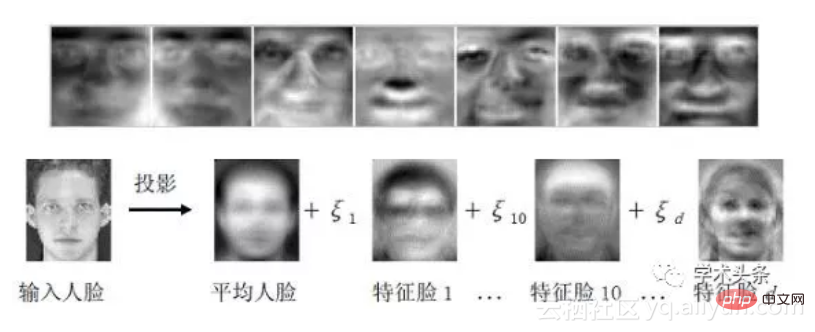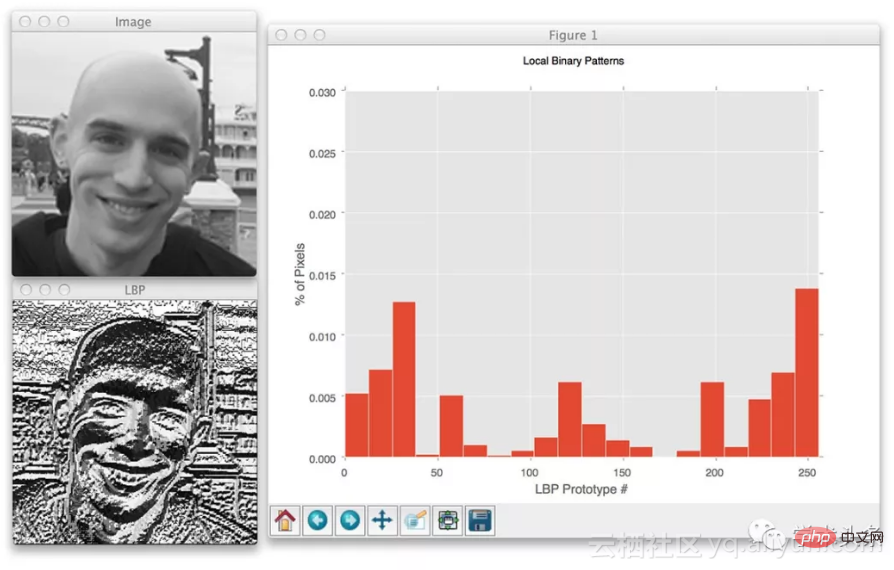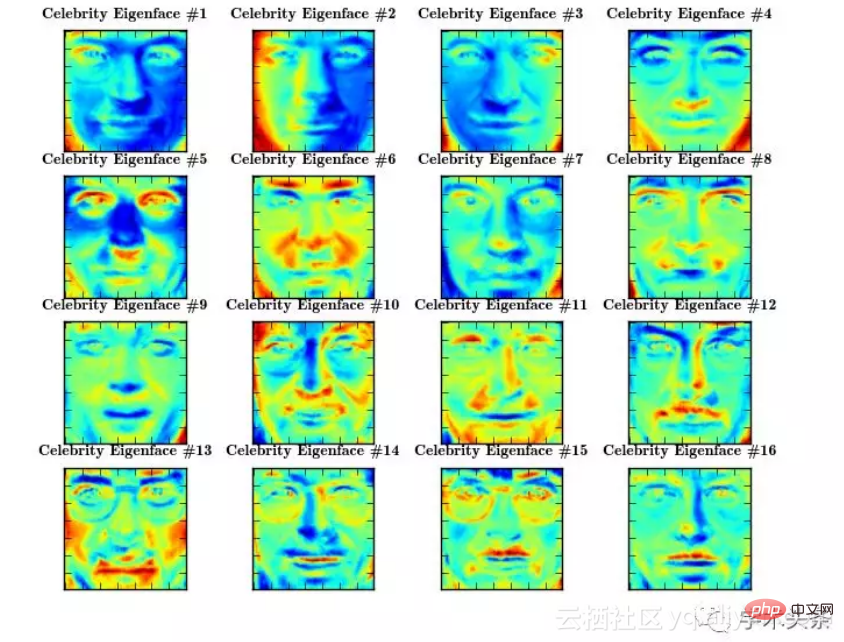What are the three classic algorithms for face recognition?
The three classic algorithms for face recognition are: Eigenface, Local Binary Patterns (LBP), and Fisherface algorithm.

Three classic algorithms for face recognition
Eigenface method ( Eigenface)
Eigenface technology is a recently developed method for face or general rigid body recognition and other methods involving face processing. The method of using eigenfaces for face recognition was first proposed by Sirovich and Kirby (1987) ("Low-dimensional procedure for the characterization of human faces") and used for face classification by Matthew Turk and Alex Pentland ("Eigenfaces for recognition" ). First, a batch of face images is converted into a set of feature vectors, called "Eigenfaces", which are the basic components of the initial training image set. The recognition process is to project a new image into the eigenface subspace, and determine and identify it through the position of its projection point in the subspace and the length of the projection line.

After transforming the image into another space, images of the same category converge together, while images of different categories converge far away. Images of different categories in the original pixel space In terms of distribution, it is difficult to divide them with simple lines or surfaces. By transforming them into another space, they can be separated well.
The spatial transformation method selected by Eigenfaces is PCA (principal component analysis). PCA is used to obtain the main components of face distribution. The specific implementation is to perform eigenvalue decomposition of the covariance matrix of all face images in the training set. The corresponding eigenvectors are obtained, and these eigenvectors are "eigenfaces". Each eigenvector or eigenface is equivalent to capturing or describing a change or characteristic between human faces. This means that each face can be represented as a linear combination of these eigenfaces.
Local Binary Patterns (LBP)
Local binary patterns (LBP) are visual algorithms used for classification in the field of computer vision. son. LBP, an operator used to describe image texture features, was proposed by T. Ojala et al. at the University of Oulu, Finland, in 1996 ("A comparative study of texture measures with classification based on featured distributions"). In 2002, T. Ojala et al. published another article on LBP ("Multiresolution gray-scale and rotation invariant texture classification with local binary patterns") on PAMI. This article very clearly explains the improved LBP features of multi-resolution, gray scale invariance, rotation invariance, and equivalent modes. The core idea of LBP is to use the gray value of the central pixel as the threshold and compare it with its field to obtain the corresponding binary code to represent the local texture features.

#LBP extracts local features as the basis for discrimination. The significant advantage of the LBP method is that it is insensitive to illumination, but it still does not solve the problems of posture and expression. However, compared with the eigenface method, the recognition rate of LBP has been greatly improved.
Fisherface algorithm
Linear discriminant analysis considers category information while reducing dimensionality. It was invented by statistician Sir R. A. Fisher in 1936 ("The use of multiple measurements in taxonomic problems" 》). In order to find a way to combine features to achieve the maximum inter-class dispersion and the minimum intra-class dispersion. The idea is simple: in a low-dimensional representation, the same classes should be clustered tightly together, while different classes should be as far apart as possible. In 1997, Belhumer successfully applied the Fisher discriminant criterion to face classification and proposed the Fisherface method based on linear discriminant analysis ("Eigenfaces vs. fisherfaces: Recognition using class specific linear projection").

For more related knowledge, please visit: PHP Chinese website!
The above is the detailed content of What are the three classic algorithms for face recognition?. For more information, please follow other related articles on the PHP Chinese website!

Hot AI Tools

Undresser.AI Undress
AI-powered app for creating realistic nude photos

AI Clothes Remover
Online AI tool for removing clothes from photos.

Undress AI Tool
Undress images for free

Clothoff.io
AI clothes remover

AI Hentai Generator
Generate AI Hentai for free.

Hot Article

Hot Tools

Notepad++7.3.1
Easy-to-use and free code editor

SublimeText3 Chinese version
Chinese version, very easy to use

Zend Studio 13.0.1
Powerful PHP integrated development environment

Dreamweaver CS6
Visual web development tools

SublimeText3 Mac version
God-level code editing software (SublimeText3)

Hot Topics
 CLIP-BEVFormer: Explicitly supervise the BEVFormer structure to improve long-tail detection performance
Mar 26, 2024 pm 12:41 PM
CLIP-BEVFormer: Explicitly supervise the BEVFormer structure to improve long-tail detection performance
Mar 26, 2024 pm 12:41 PM
Written above & the author’s personal understanding: At present, in the entire autonomous driving system, the perception module plays a vital role. The autonomous vehicle driving on the road can only obtain accurate perception results through the perception module. The downstream regulation and control module in the autonomous driving system makes timely and correct judgments and behavioral decisions. Currently, cars with autonomous driving functions are usually equipped with a variety of data information sensors including surround-view camera sensors, lidar sensors, and millimeter-wave radar sensors to collect information in different modalities to achieve accurate perception tasks. The BEV perception algorithm based on pure vision is favored by the industry because of its low hardware cost and easy deployment, and its output results can be easily applied to various downstream tasks.
 Implementing Machine Learning Algorithms in C++: Common Challenges and Solutions
Jun 03, 2024 pm 01:25 PM
Implementing Machine Learning Algorithms in C++: Common Challenges and Solutions
Jun 03, 2024 pm 01:25 PM
Common challenges faced by machine learning algorithms in C++ include memory management, multi-threading, performance optimization, and maintainability. Solutions include using smart pointers, modern threading libraries, SIMD instructions and third-party libraries, as well as following coding style guidelines and using automation tools. Practical cases show how to use the Eigen library to implement linear regression algorithms, effectively manage memory and use high-performance matrix operations.
 Explore the underlying principles and algorithm selection of the C++sort function
Apr 02, 2024 pm 05:36 PM
Explore the underlying principles and algorithm selection of the C++sort function
Apr 02, 2024 pm 05:36 PM
The bottom layer of the C++sort function uses merge sort, its complexity is O(nlogn), and provides different sorting algorithm choices, including quick sort, heap sort and stable sort.
 How to turn off face recognition on Apple phone_How to disable face recognition on Apple phone settings
Mar 23, 2024 pm 08:20 PM
How to turn off face recognition on Apple phone_How to disable face recognition on Apple phone settings
Mar 23, 2024 pm 08:20 PM
1. We can ask Siri before going to bed: Whose phone is this? Siri will automatically help us disable face recognition. 2. If you don’t want to disable it, you can turn on Face ID and choose to turn on [Require gaze to enable Face ID]. In this way, the lock screen can only be opened when we are watching.
 How to enter DingTalk face recognition
Mar 05, 2024 am 08:46 AM
How to enter DingTalk face recognition
Mar 05, 2024 am 08:46 AM
As an intelligent service software, DingTalk not only plays an important role in learning and work, but is also committed to improving user efficiency and solving problems through its powerful functions. With the continuous advancement of technology, facial recognition technology has gradually penetrated into our daily life and work. So how to use the DingTalk app for facial recognition entry? Below, the editor will bring you a detailed introduction. Users who want to know more about it can follow the pictures and text of this article! How to record faces on DingTalk? After opening the DingTalk software on your mobile phone, click "Workbench" at the bottom, then find "Attendance and Clock" and click to open. 2. Then click "Settings" on the lower right side of the attendance page to enter, and then click "My Settings" on the settings page to switch.
 Improved detection algorithm: for target detection in high-resolution optical remote sensing images
Jun 06, 2024 pm 12:33 PM
Improved detection algorithm: for target detection in high-resolution optical remote sensing images
Jun 06, 2024 pm 12:33 PM
01 Outlook Summary Currently, it is difficult to achieve an appropriate balance between detection efficiency and detection results. We have developed an enhanced YOLOv5 algorithm for target detection in high-resolution optical remote sensing images, using multi-layer feature pyramids, multi-detection head strategies and hybrid attention modules to improve the effect of the target detection network in optical remote sensing images. According to the SIMD data set, the mAP of the new algorithm is 2.2% better than YOLOv5 and 8.48% better than YOLOX, achieving a better balance between detection results and speed. 02 Background & Motivation With the rapid development of remote sensing technology, high-resolution optical remote sensing images have been used to describe many objects on the earth’s surface, including aircraft, cars, buildings, etc. Object detection in the interpretation of remote sensing images
 Can artificial intelligence predict crime? Explore CrimeGPT's capabilities
Mar 22, 2024 pm 10:10 PM
Can artificial intelligence predict crime? Explore CrimeGPT's capabilities
Mar 22, 2024 pm 10:10 PM
The convergence of artificial intelligence (AI) and law enforcement opens up new possibilities for crime prevention and detection. The predictive capabilities of artificial intelligence are widely used in systems such as CrimeGPT (Crime Prediction Technology) to predict criminal activities. This article explores the potential of artificial intelligence in crime prediction, its current applications, the challenges it faces, and the possible ethical implications of the technology. Artificial Intelligence and Crime Prediction: The Basics CrimeGPT uses machine learning algorithms to analyze large data sets, identifying patterns that can predict where and when crimes are likely to occur. These data sets include historical crime statistics, demographic information, economic indicators, weather patterns, and more. By identifying trends that human analysts might miss, artificial intelligence can empower law enforcement agencies
 Application of algorithms in the construction of 58 portrait platform
May 09, 2024 am 09:01 AM
Application of algorithms in the construction of 58 portrait platform
May 09, 2024 am 09:01 AM
1. Background of the Construction of 58 Portraits Platform First of all, I would like to share with you the background of the construction of the 58 Portrait Platform. 1. The traditional thinking of the traditional profiling platform is no longer enough. Building a user profiling platform relies on data warehouse modeling capabilities to integrate data from multiple business lines to build accurate user portraits; it also requires data mining to understand user behavior, interests and needs, and provide algorithms. side capabilities; finally, it also needs to have data platform capabilities to efficiently store, query and share user profile data and provide profile services. The main difference between a self-built business profiling platform and a middle-office profiling platform is that the self-built profiling platform serves a single business line and can be customized on demand; the mid-office platform serves multiple business lines, has complex modeling, and provides more general capabilities. 2.58 User portraits of the background of Zhongtai portrait construction





